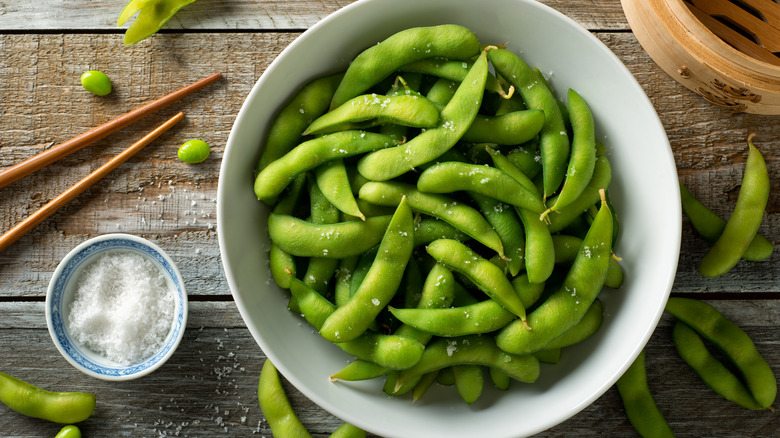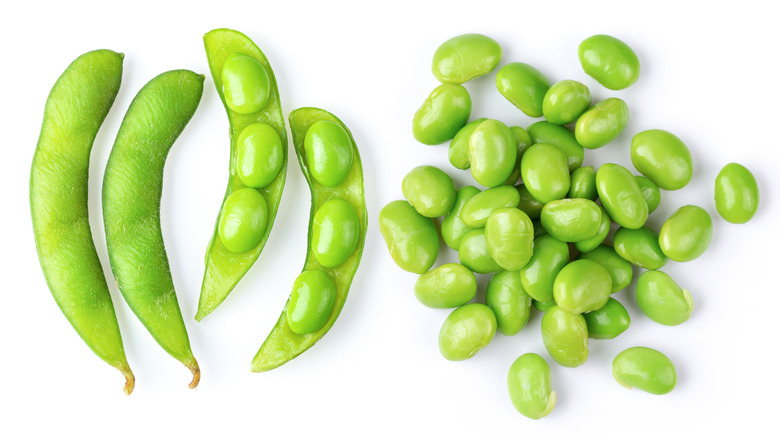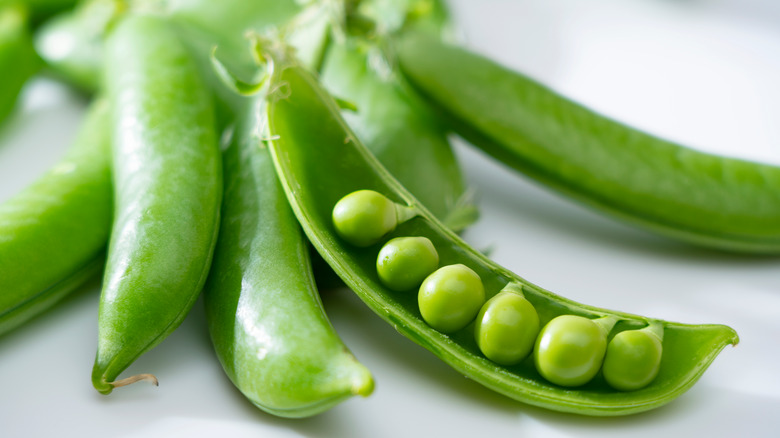Edamame Vs. Snap Peas: What's The Difference?
Occasionally, one food is confused for another — luckily, most edible plants possess enough unique characteristics in their original state to make it a rare occurrence — with the exception of grocery deliveries, where it seems to happen with more frequency. Cilantro and parsley are often mistaken for each other although on the palate they're quite different. Bananas and plantains look similar but are unalike in flavor and preparation, as plantains have to be cooked prior to being eaten while bananas become a mushy mess with heat, which is not necessarily a bad thing depending on your recipe. And it's common knowledge that it's dangerous to mix up fungi; poisonous toadstools too closely resemble edible mushrooms, but if you're foraging at the market it's not a concern.
Edamame and sugar snap peas are another set of foodstuffs that can be misidentified. According to Everyday Health, they're both legumes, yet a significant distinction is that the pods of one are consumed while those of the other must be discarded. Close in size, color, and shape, they seem bent on baffling us. It's no fun to get home from a grocery run (especially if you've been running all day) and realize you've selected the wrong thing. We're highlighting these two specifically to share how they can easily be distinguished and when the bean or pea might be the better option.
Edamame
According to Healthline, edamame (Glycine max) are immature soybeans also called green or vegetable-type soybeans. Per Savvy Gardening, they're low-maintenance and easy to grow, sharing cultivation similarities with bush bean varieties like the string bean (also called the snap bean to make matters even more confounding), although edamame is a more prolific crop (via The Old Farmer's Almanac).
The mature pods and the dried soybeans that are harvested are processed into a myriad of soy-based products available for consumption including tofu, tempeh, miso, and soymilk. However, the young, green soybeans are generally simply steamed and salted, and the beans are removed and the pods discarded before being eaten. They are sweet and nutty with an appealing creaminess. In addition to their popularity as a (somewhat laborious) snack, edamame might appear as a component of Japanese and Chinese cuisine, such as stir-fries, noodle dishes, salads, and soups per Healthline.
Everyday Health notes that edamame is rich in protein — in fact, it's one of the few foods that are a complete protein — omega-3 fatty acids, and other essential nutrients. Available at markets frozen or fresh, frozen packaged edamame is usually sold shelled, eliminating much of the prep and making it a simple, healthy addition to any of the dishes above. Fresh edamame pods are plump, vibrant green, and fuzzy (as opposed to smooth and glossy snap peas) and only contain two to three beans within the shell.
Snap peas
Per The Kitchn, snap peas (Pisum sativum var. Macrocarpon) are a climbing legume, along with snow and English peas, and they are actually a cross between the two. However, according to HGTV, they can also be found in compact, bush varieties. Snap peas mature quickly and are best picked before they grow starchy and fibrous. The ideal specimens are bright and firm with a satisfying crunch, notes The Old Farmer's Almanac. Meant to be eaten shell and all, they can be enjoyed as a crispy snack, sliced raw into salads, or added to various cooked dishes. You'll first want to remove the string that runs along the side (although many 'stringless' cultivars are available to gardeners now). The Kitchn suggests serving them blanched, as a side with lemon and mint, or as part of a garlicky stir-fry. Plus, the outlet contends they're a great candidate for pickling and roasting.
According to Very Well Fit, snap peas are high in vitamin C, iron, fiber, and protein, and while they taste sweet fresh from the garden, they won't cause a spike in blood sugar. They're sold fresh and frozen; when buying fresh, look for shiny fat pods (though difficult to open when ripe, inside you'll find several small peas). Harvest to Table recommends storing them unwashed inside a plastic bag in the refrigerator for no longer than a few days.
So the next time you're at the grocery store make sure to double-check if you've got edamame or snap peas in your basket; you wouldn't want to munch on an edamame pod or throw out most of a crunchy snap pea by mistake.


